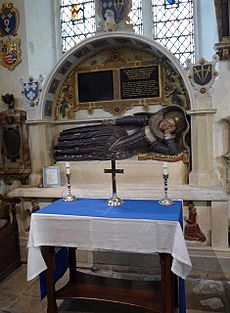St Mary's Church, Stoke d'Abernon facts for kids
Quick facts for kids St Mary's Church, Stoke d'Abernon |
|
|---|---|
 |
|
| 51°18′50″N 0°22′52″W / 51.31389°N 0.38111°W | |
| OS grid reference | TQ 129 584 |
| Location | Stoke d'Abernon |
| Country | England |
| Denomination | Church of England |
| Website | St Mary's, Stoke d'Abernon |
| History | |
| Dedication | Mary the Virgin |
| Architecture | |
| Heritage designation | Grade I |
| Designated | 14 August 1953 |
| Administration | |
| Diocese | Diocese of Guildford |
The Church of St Mary is a very old church located in the village of Stoke d'Abernon, Surrey, England. It's part of the Church of England. Some parts of this church are from the 7th century, making it incredibly ancient! It's also a special building, protected as a Grade I listed site.
Contents
Discovering St Mary's Church
A Look at Its Long History
The first church here was built way back in the 7th century. That's over 1300 years ago! When they built it, they even reused old bricks and stones from Roman buildings. This church was one of the first in the area. It was built soon after Saint Augustine, the first Archbishop of Canterbury, brought Christianity to England.
This church was once a "private church" (called an ecclesia propria). This means a powerful local lord built it on his own land. There's a high-up doorway in the south wall, now blocked. This door used to lead to the lord's special gallery. Until the 13th century, the lord of the manor had his own private chapel there.
The nave is the main part of the church where people sit. The north side of the nave was added around 1190. You can still see the stonework of an old entrance in the south wall. This entrance was blocked up in 1866, but it was probably an older Saxon doorway that was changed.
The Unique Pulpit
The pulpit, where the priest gives sermons, was a gift from Sir Francis Vincent in 1620. He became a special kind of knight called a baronet that year. His family's coat of arms and motto are on the "sounding board" above the pulpit. This board helps the sound of the speaker's voice carry.
The pulpit itself is shaped like a seven-sided figure (a heptagon) and is made of walnut wood. It stands on a central column and is supported by seven interesting figures. These figures are part-animal and part-human, called caryatids.
Church Chest and Organ
Below the pulpit, there's an old oak chest. It dates back to the late 12th or early 13th century. At the west end of the nave, you'll find the organ. It was specially made for this church by a company called Frobenius from Denmark in 1975.
The Chancel Area
The chancel is the part of the church near the altar. It was built around 1240, replacing an older, rounded Saxon area. The ceiling here has a special criss-cross pattern called a quadripartite vault.
Famous Memorial Brasses
In front of the altar, there are two very famous brass pictures on the floor. These are memorials to Sir John d'Abernon (who passed away in 1277) and his son, also named Sir John d'Abernon (who passed away in 1327). The brass of Sir John the Elder is considered one of the best in the world! It shows him as a knight in full armor. He carries both a lance and a sword, which is very rare to see together on a brass. You can even see some of the original blue color on his shield.
The arch that connects the nave to the chancel was made wider in 1866. This was part of a big restoration project by architects Ford and Hesketh.
The Norbury Chapel
The Norbury Chapel is on the north side of the chancel. Sir John Norbury (who passed away in 1521) built it around 1490. He built it to remember the victory at the Battle of Bosworth. His own memorial, showing a knight kneeling, is on the east wall of the chapel.
There are also monuments to Sir Thomas Vincent (who passed away in 1613) and Lady Jane Vincent (who passed away in 1619) by the north wall. On the east wall, there's a monument to Lady Sarah Vincent (who passed away in 1608), who was their daughter-in-law. These monuments have life-sized painted statues of the people they remember.
The ashes of Edgar Vincent, 1st Viscount D'Abernon (1857–1941) are also kept in the east wall of this chapel.
See also
- Grade I listed buildings in Surrey
- List of places of worship in Elmbridge
- Monumental brass



